skyscraper
As skyscrapers refers particularly high skyscrapers . Usually the term is used from a height of 150 meters , although this height mark may vary depending on the context and region.
Often viewed as symbols of economic power and the pursuit of growth , they can serve representative purposes for their builders and owners. In many densely built-up cities, they are simply an expression of a lack of space and high demand. The German term is a loan translation of the English skyscraper , which in turn comes from the technical language of seafarers, where it denotes the highest mast of a sailing ship .
Demarcation
A building is primarily characterized by the fact that it is used by people for living and working. Skyscrapers are usually solitary buildings with a tower-like character and a high degree of urban autonomy. These features and the great height make it a special form of high-rise - a designation that generally applies to all buildings with a height of more than 22 meters (floor height of the highest usable floor) or more than approx. 6-7 floors.
Broadcasting or television towers such as the CN Tower in Toronto or observation towers such as the Eiffel Tower are not counted among the skyscrapers , as the fewest levels of these are used for living or working. Such towers are therefore not referred to as buildings, but as (free-standing) structures .
The currently tallest building and structure in the world is the Burj Khalifa (during the Burj Dubai construction phase ) in Dubai with a structural height of 828 meters, a total height of 830 meters and 163 usable floors (at least 189 total). It peaked in January 2009 and opened in January 2010.
history
precursor
Pyramids
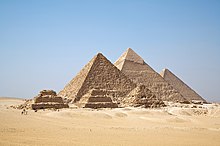
The Egyptian pyramids , in particular the pyramids of Giza , can be regarded as the first "skyscrapers" (approx. 2500 BC). The highest of the three pyramids, the Great Pyramid , originally 146 meters high, is still 137 meters today.
The Mesopotamian counterpart to the pyramids were the ziggurats in what is now Iraq . The reconstructed ziggurat of the moon god Nanna was around 25 meters high. The most famous ziggurat is already in the Bible mentioned Tower of Babel , a ziggurat in Babylon, are obtained from the foundations.
The Toltec , Aztec and Mayan pyramids are known from Central America . The main pyramid of Teotihuacán in what is now Mexico was 63 meters high. The main pyramid of Tikal in present-day Guatemala reached a height of 47 meters.
The Nataraja Temple in Chidambaram in southern India was built with 45 meter high, steeply tiered pyramids in the 13th century.
Antique high-rise buildings
On the fresco of the “ Ship Procession ” in Akrotiri on Santorini , which shows a procession of ships on the journey from Thira to Crete , multi-storey houses can be seen, which were also proven during the excavations in Akrotiri.
In the Roman Empire , at least in Rome and its port, Ostia, there were four to five-story high-rise buildings, called insulae in Latin . Papyri from Oxyrhynchus indicate seven-story skyscrapers around 300 AD in Hermopolis Magna in what is now Egypt .
Medieval residential towers
In the Middle Ages, there were residential towers in many Italian cities, which were built by influential urban families for reasons of prestige ( gender tower ). Particularly famous are the towers of Bologna from the 12th and 13th centuries, of which just under 20 have survived. Several of the preserved towers are around 60 meters high, the Asinelli tower even has a height of 97 meters.
The city of San Gimignano in Tuscany still has a medieval cityscape with some residential towers. Fifteen of the 72 towers of the family still exist today. The two highest, the Torre Grossa from 1311 and the Torre della Rognosa, are 54 and 51 meters high, respectively.
Six to seven-storey houses from the 16th century are also known from the city of Shibam in Hadramaut in Yemen .
19th century
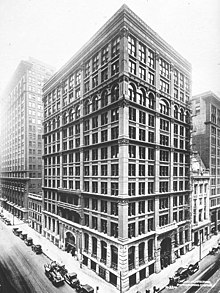
At the end of the 19th century and the beginning of the 20th century , the US cities excelled with the construction of ever taller buildings, especially Chicago - which is considered the birthplace of skyscrapers - and New York .
The Great Chicago Fire of 1871 destroyed 17,450 buildings in the heart of the city's business district. Construction work on 300 new buildings began within six weeks, opening up completely new horizons for architecture. Between 1880 and 1890, Chicago's population doubled to over a million, which caused an explosion in downtown land prices. A square meter cost 130 US dollars in 1880 , but by 1890 it increased sevenfold to almost 900 US dollars.
In order to be profitable, landowners began to use their land to the maximum - which meant building higher. This was made possible thanks to new inventions such as electric elevator systems , fireproof building materials, but above all through the development of skeleton construction and steel frame construction in building construction . On May 22, 1888, the architect Leroy S. Buffington from Minneapolis received the US patent (number 383,170) for a construction method for steel structures.
The Home Insurance Building from 1885 (demolished in 1931) was the first structure to combine the new technical achievements and, with its ten floors, is considered the first high-rise in the world. The Auditorium Building , built in 1889 by Dankmar Adler and Louis Sullivan , also had an air conditioning system as a novelty - in addition to its almost perfect acoustics .
Around the first steel frame buildings in Chicago, a group of architects, William Le Baron Jenney , Louis Sullivan, Daniel Burnham , William Holabird and Martin Roche , who are now known as the Chicago School , arose . This group shaped the economic architecture of Chicago and the east of the USA significantly.
Between 1890 and 1894 the Reliance Building was built, which is considered to be the forerunner of the glass curtain wall construction that would later determine the “international style”. It is considered a masterpiece of the Chicago School .
In 1892 New York City entered the race for the tallest building for the first time. The New York World Building , also known as the Pulitzer Building , was overtaken by the 22-story Chicago Masonic and Women's Temple that same year . However, the World Building, including the antenna, was around two meters higher than the Masonic Temple , making the height record questionable. For some, the World Building was the tallest building, for others the Masonic Temple . Both buildings were demolished over time.
In 1894, the Manhattan Life Building exceeded the 100 meter mark for the first time at 106 meters.
In 1899 the Park Row Building was completed in New York , which with a height of 119 meters was the tallest building in the world until 1908. Contrary to many other claims, the world-famous 87 meter high Fuller Building (or Flatiron Building ) was never the tallest building in the world.
First half of the 20th century
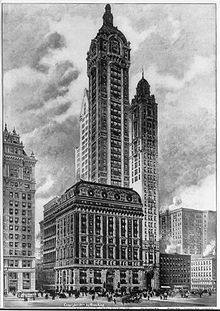

The City Council of Philadelphia ( Philadelphia City Hall ) is not really a high-rise building, the city hall tower is therefore mostly as a tower and not as a skyscraper viewed. Still, from 1901 to 1908, at 167 meters, it was taller than the officially tallest skyscraper, the 119-meter Park Row Building .
The first skyscraper with a height of over 150 meters was completed in New York in 1908: the Singer Building with a height of 187 meters and an extremely ornate, colorful and palatial facade. Despite its historical importance, the Singer Building was demolished in 1968 to make way for One Liberty Plaza , also known as the US Steel Building . To this day, the Singer Building is the tallest building in the world that has been demolished in a controlled manner.
In 1909, the 213 meter high Metropolitan Life Tower ( Met Life Tower ) was also built in New York . The next skyscrapers, which were the tallest in the world at the time of their construction, were also built in New York: 241 meters high and significantly more massive than all its predecessors, the Woolworth Building , built in 1913 and nicknamed because of its shape, appearance and function " Cathedral of Commerce" received.
The Equitable Building , built in 1915 , forcibly ushered in a new architectural style: Due to its massive construction, it took away the sunlight from the many smaller buildings in the area. According to the 1916 zoning resolution for New York City , buildings had to be thinner towards the top. Although this law only applied in New York, this architectural style was also used in other cities, even if there was no requirement there.
In 1924, with the American Radiator Building, the Art Deco style flowed into the architecture of the skyscrapers for the first time , which has had a decisive influence on the cityscape, especially in New York. At about the same time, with about two years longer construction time, the Barclay-Vesey Building was also built in New York . The Barclay-Vesey Building is considered to be the first to begin and the American Radiator Building to be the first to be completed in the Art Deco style.
In 1929 there was an interesting race in New York for the tallest building. In Downtown , the tower was Bank of Manhattan , today as 40 Wall Street known in Midtown, the Chrysler Building built. For a short time, the builders of 40 Wall Street believed they had won the race with 283 meters, but William Van Alen , the architect of the Chrysler Building , had the point hidden inside the building and moved into its final position on October 23, 1929. In the end, the Chrysler Building was significantly higher at 319 meters and exceeded the 300-meter mark for the first time. The Chrysler Building still enjoys a certain reputation as the “most beautiful skyscraper of all time”, which is based in particular on its elegant, curved roof construction.
As early as 1931, the Empire State Building followed with a height of 381 meters (449 meters with the antenna installed in 1950, 443 meters after the antenna was replaced in 1984), made famous by the movie King Kong and the White Woman . The Empire State Building remained the tallest building on earth until 1972. This made it the longest to hold the world record of all high-rise buildings. On the one hand, this was due to economic reasons, on the other hand, with the classic steel frame, the technical possibilities were gradually exhausted.
The 150 meter high PSFS Building , completed in Philadelphia in 1932, is considered the first skyscraper in the International Style . There have been other buildings such as the Grant Building (1928) in Pittsburgh , where less emphasis was placed on ornamentation and more emphasis on glass, or the McGraw-Hill Building (1931) in New York, which was even more on the concept the International style is based, however, in these buildings, other styles were involved, and both were stepped after the zoning resolution built. The PSFS Building was built without any ornamentation or gradation.

In 1932 construction began on the Metropolitan Life North Tower , now also known as the Metropolitan Life North Building ( Met Life North Building ). It was originally supposed to have 100 floors and be around 400 meters high. Due to problems with financing due to the global economic crisis , construction was stopped in 1933 on the 29th floor. It was only completed in 1950 at a height of 137.5 meters and 30 floors. Technically speaking, the building could be expanded to the height planned at the time at any time.
After the Second World War, construction was mainly carried out in the international style . Concrete, stones and ornaments took a back seat, the facades consisted mainly of steel or aluminum and glass. The Lever House and Seagram Building were among the first of this generation.
Second half of the 20th century

In 1969, the completion of the John Hancock Center began another competition for the tallest building in the world, which at 344 meters towered over all buildings in the world except the Empire State Building.
In 1972 the first of the two towers of the World Trade Center was completed at 417 meters . With the antenna erected in 1978 on the north tower (WTC 1), the World Trade Center even reached 527 meters. The southern tower was 415 meters.
In 1974, the Sears Tower, since July 2009 the Willis Tower , opened in Chicago . With a height of 442 meters, it took over the title of the tallest building in the world. It was only in 1998 that the Petronas Towers in Kuala Lumpur, at 452 meters high , took this title from him. The record of the Petronas Towers is controversial, however, as the Willis Tower is significantly higher up to the roof or to the highest floor, has a much higher total height up to the top of the mast and many more floors (for the height dispute see below, height measurement in skyscrapers ). The World Trade Center, which was destroyed in 2001, was taller than the Petronas Towers in all of the categories mentioned.
21st century

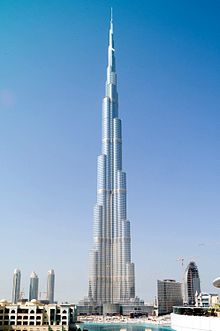
In 2004 the Taipei 101 was opened in Taipei . It is 508 meters high and replaced the Petronas Towers as the tallest building in the world. However, the Willis Tower remained the tallest building with its antenna tip at 527 meters according to the criterion of height to the top.
On January 17, 2009, the Burj Khalifa reached its structural and official final height of 828 meters and, with its 830 meters to the top, is not only the tallest skyscraper, but also the world's tallest structure ever erected. It was the first time since the construction of the Empire State Building that the title of the tallest structure (which also includes transmission masts and towers) went back to a skyscraper. The building opened on January 4, 2010.
In Europe, in December 2003, the Triumph Palace in Moscow, with 264 meters and 54 floors, replaced the Commerzbank Tower in Frankfurt am Main, with 56 floors , at first place in the ranking of the tallest building in Europe. In 2007, the title went to Naberezhnaya Tower C, which is slightly higher at 268 meters . In 2010, the Capital City Moscow Tower reached the 300 meter mark for the first time, making it the first “supertall skyscraper” in Europe. With the exception of the 310-meter-high The Shard in London , built in 2012 , all subsequent titleholders came from Moscow until 2018. The Lakhta Center in St. Petersburg has been the tallest skyscraper again since 2018 . (see list of skyscrapers in Europe ).
In Beijing in 2009, a new form of skyscraper in the shape of a bracket or a loop was created with the 234 meter high building of the China Central Television Headquarters (CCTV) by architect Rem Koolhaas. This design was also considered significant, although this building, with its comparatively low height, did not contribute to a record.
Future development
More skyscrapers have been built again since the 1990s. While it took decades after the completion of the Empire State Building (1931) and the Sears Tower (1974; today's name Willis Tower) to reach the next height record, this period has been reduced to a few years since 1998.
A total of around 27 buildings with a height of more than 400 meters are currently under construction. The financial crisis from 2007 onwards led to some construction stops or total deletions. The trend towards high-rise buildings remains fundamentally unbroken, with too many economic, settlement-economic and (but this is controversial) ecological reasons speaking for it.
A lot of super tall skyscrapers will be built by 2015, so the list of tallest skyscrapers in the upper range will change. Many of the new record skyscrapers are being built or are planned in Asia, but some will also be in the USA.
From a technical point of view, the maximum height of skyscrapers that can be reached is around 1.5 to 2 km - although higher structures could be constructed, they could hardly be used as buildings, since the skyscraper could almost only support its own construction. However, it is possible that this limit will be pushed up further in the future through the use of new artificial materials. Apart from the technical feasibility, however, the question of the financing of such a building project and its later economic viability must be considered, which are further factors that may influence the decision to build such a building.
→ See list of tallest buildings in the world: The tallest skyscrapers under construction ; Building with construction freeze
The Nakheel Tower with a height of over 1,000 meters was announced for Dubai, which should have replaced the Burj Khalifa as the tallest building and structure in the world. This construction project, calculated over a ten-year construction period, was abandoned in December 2009.
The Kingdom Tower in Saudi Arabia , which has been under construction since 2013, is expected to be over 1,000 meters high, the opening has been postponed further and further and will now be well after 2020.
Height measurement at skyscrapers
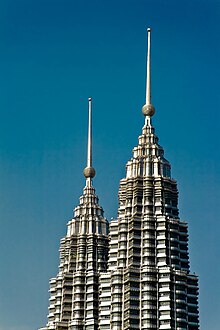

The international commission Council on Tall Buildings and Urban Habitat (CTBUH) is the "guardian" of the records of tall buildings, which determines the official height records of the tallest buildings in the world on the basis of the height information available to it. Originally four categories were defined for the ranking of the buildings, currently only three of them apply.
Measurements are taken from the level of the lowest, open-air main entrance for pedestrians to the building ('Height is measured from the level of the lowest, significant, open-air, pedestrian entrance to ...'):
- Height to the architectural top ("construction tip"; "Height to Architectural Top");
- Height to the highest usable floor ('Highest Occupied Floor');
- Height to the highest building top including antenna or other structures ('Height to Tip').
The fourth category, height to the roof , was abolished in 2009 because the roof of many newer buildings can no longer be clearly defined due to the architecture .
The height up to the absolute peak is only used in height comparisons when a building is generally mentioned. Therefore, when comparing two buildings, it can happen again and again that one is the taller building, but the other is the taller structure. The Jin Mao Tower in Shanghai, for example, has an architectural height of 421 meters, but has no antenna. The Empire State Building has a total height to the top of the antenna of 443 meters, but an architectural height of only 381 meters. Thus, the Jin Mao Tower is called the taller building, but not the taller structure.
Especially when it comes to the world record, there are always differences of opinion. The Petronas Towers in Kuala Lumpur have a roof height of 378 meters, the highest floor is 375 meters. There is still a metal spike on the roof, making it 452 meters. Since the metal spikes are used for the construction of the building, the towers received the official world record in 1998 for the tallest building. A heated discussion ensued. The Willis Tower in Chicago (until 2009 Sears Tower ) has a roof and construction height of 442 meters, the highest floor is 412 meters. This would make the Willis Tower significantly higher than the Petronas Towers in at least two of the three categories. It is also highly controversial whether the metal spikes of the Petronas Towers can even be counted towards the architectural height of the building, otherwise the antenna of the Willis Tower would also have to be taken into account when comparing the official height , which means that it is 527 meters high to the top.
The more and more numerous skyscrapers that have been built in recent times and are reaching higher and higher have meant that further sub-groups have been introduced according to structural height :
- Skyscraper: 150–299.99 meters, construction time around 2–4 years
- Super tall skyscraper: 300–499.99 meters, construction time around 3–5 years
- Hyper tall skyscraper: 500+ meters, construction time about 5+ years
reception
The importance of the buildings led u. a. to the fact that since 2004 there has been a Skyscraper Museum as an architecture museum at Battery Park in Manhattan, New York City, founded in 1996 .
Historical development of the individual records since 1930
→ Main article: List of tallest structures of their time
| year | event | Highest structural height | Height of the highest usable floor | Highest overall height |
|---|---|---|---|---|
| 1930 | Chrysler Building completed | Chrysler Building (319 m) | Chrysler Building (274 m) | Chrysler Building (319 m) |
| 1931 | Empire State Building completed | Empire State Building (381 m) | Empire State Building (373 m) | Empire State Building (381 m) |
| 1950 | Antenna mounting on the Empire State Building | Empire State Building (381 m) | Empire State Building (373 m) | Empire State Building (449 m) A. |
| 1969 | John Hancock Center completed (including antenna assembly) |
Empire State Building (381 m) | Empire State Building (373 m) | John Hancock Center (457 m) |
| 1972 | World Trade Center 1 opens | World Trade Center (417 m) | World Trade Center (413 m) | John Hancock Center (457 m) |
| 1974 | Willis Tower (until 2009 Sears Tower) completed | Willis Tower (Sears Tower) (442 m) | World Trade Center (413 m) | John Hancock Center (457 m) |
| 1978 | Antenna installation on World Trade Center 1 | Willis Tower (Sears Tower) (442 m) | World Trade Center (413 m) | World Trade Center (527 m) |
| 1998 | Petronas Towers completed | Petronas Towers (452 m) | World Trade Center (413 m) | World Trade Center (527 m) |
| 2000 | Willis Tower antenna extension | Petronas Towers (452 m) | World Trade Center (413 m) | World Trade Center (527 m) + Willis Tower (527 m) |
| 2001 | World Trade Center destroyed | Petronas Towers (452 m) | Willis Tower (412 m) | Willis Tower (527 m) |
| 2004 | Taipei 101 opened | Taipei 101 (508 m) | Taipei 101 (438 m) | Willis Tower (527 m) |
| 2008 | Shanghai World Financial Center completed | Taipei 101 (508 m) | Shanghai World Financial Center (474 m) | Willis Tower (527 m) |
| 2010 | Burj Khalifa opens | Burj Khalifa (828 m) | Burj Khalifa (584 m) | Burj Khalifa (830 m) |
See also
Earth scraper
In contrast to the skyscraper, the world's first skyscraper built down into the ground was dubbed by the media as an "earth scraper". The building, which is used as a hotel, was erected in a disused quarry in China in the Songjiang district around thirty kilometers southwest of Shanghai . It has 18 floors, of which only the top two protrude above the surface of the earth. The remaining floors are 88 meters deep, the two lowest even under water. After around five years of construction, the hotel opened at the end of 2018.
A skyscraper built completely underground was planned in Mexico City in 2011 , but has not yet been implemented.
literature
- Matthias Alexander / Gerd Kittel: " Skyscrapers in Frankfurt ". Frankfurt am Main: Societäts-Verlag, 2006. ISBN 3-7973-1000-5
- Leonello Calvetti / Christ Oxlade: “ Uncovering - looking through. Skyscraper ”. Tessloff, 2004. ISBN 3-7886-1403-X
- Andres Lepik: " Skyscraper ". Munich: Prestel Verlag, 2005. ISBN 3-7913-3454-9
- Lewis Mumford : " From log cabin to skyscraper ". Berlin: Gebr. Mann, 1997. ISBN 3-7861-1943-0
- Antonino Terranova: " Skyscraper ". Cologne: Karl Müller, 2003. ISBN 3-89893-084-X
- Carol Willis: Form Follows Finance: Skyscrapers and Skylines in New York and Chicago. Princeton Architectural Press, 1995. 224 pp. ISBN 1-56898-044-2 (Director of the Skyscraper Museum in NYC)
Web links
- Deutschlandfunk.de Science in Focus April 19, 2020, Maximilian Schönherr : New skyscrapers in the cityscape
- Website of the CTBUH (English)
- Skyscraper Forum (English) with German-language sub- forum
- Information and diagrams of skyscrapers on skyscraperpage (English)
- Information about skyscrapers (English)
- Skyscrapers pictures (English)
- Visual and interactive comparison of skyscrapers on Size-Explorer (German, multilingual)
Individual evidence
- ↑ Ernst Seidl (ed.): Lexicon of building types. Functions and forms of architecture . Philipp Reclam jun. Verlag, Stuttgart 2006, ISBN 978-3-15-010572-6 .
- ^ What is a Tall Building? CTBUH (English)
- ↑ Papyrus Oxyrhynchus 2719, in: Katja Lembke , Cäcilia Fluck, Günter Vittmann: Ägyptens late bloom. Die Römer am Nil , Mainz 2004, ISBN 3-8053-3276-9 , page 29
- ↑ Old Walled City of Shibam
- ↑ U.S. Patent No. 383,170 to Leroy S. Buffington , accessed May 22, 2009.
- ^ Metropolitan Life North Building , skyscraperpage.com
- ^ The 100 tallest buildings in the world under-construction , CTBUH
- ↑ Askohneantwort.de ( Memento of the original from June 27, 2010 in the Internet Archive ) Info: The archive link was inserted automatically and has not yet been checked. Please check the original and archive link according to the instructions and then remove this notice.
- ↑ CTBUH Criteria for Defining and Measuring Tall Buildings , CTBUH website
- ↑ China: "Intercontinental Shanghai Wonderland" - the luxury hotel in the quarry. LAMUNDUS, November 27, 2018, accessed December 1, 2018 .
- ↑ Fish in front of the window Luxury hotel built in a quarry. Hamburger Morgenpost , November 27, 2018, accessed on December 1, 2018 .
- ↑ Two floors under water This new hotel is located in an old quarry. Kölner Stadt-Anzeiger , November 27, 2018, accessed on December 1, 2018 .
- ↑ A skyscraper that grows into the earth. October 14, 2011, accessed December 1, 2018 .


